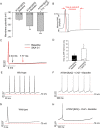Targeting potassium channels to treat cerebellar ataxia
- PMID: 29560375
- PMCID: PMC5846455
- DOI: 10.1002/acn3.527
Targeting potassium channels to treat cerebellar ataxia
Abstract
Objective: Purkinje neuron dysfunction is associated with cerebellar ataxia. In a mouse model of spinocerebellar ataxia type 1 (SCA1), reduced potassium channel function contributes to altered membrane excitability resulting in impaired Purkinje neuron spiking. We sought to determine the relationship between altered membrane excitability and motor dysfunction in SCA1 mice.
Methods: Patch-clamp recordings in acute cerebellar slices and motor phenotype testing were used to identify pharmacologic agents which improve Purkinje neuron physiology and motor performance in SCA1 mice. Additionally, we retrospectively reviewed records of patients with SCA1 and other autosomal-dominant SCAs with prominent Purkinje neuron involvement to determine whether currently approved potassium channel activators were tolerated.
Results: Activating calcium-activated and subthreshold-activated potassium channels improved Purkinje neuron spiking impairment in SCA1 mice (P < 0.05). Additionally, dendritic hyperexcitability was improved by activating subthreshold-activated potassium channels but not calcium-activated potassium channels (P < 0.01). Improving spiking and dendritic hyperexcitability through a combination of chlorzoxazone and baclofen produced sustained improvements in motor dysfunction in SCA1 mice (P < 0.01). Retrospective review of SCA patient records suggests that co-treatment with chlorzoxazone and baclofen is tolerated.
Interpretation: Targeting both altered spiking and dendritic membrane excitability is associated with sustained improvements in motor performance in SCA1 mice, while targeting altered spiking alone produces only short-term improvements in motor dysfunction. Potassium channel activators currently in clinical use are well tolerated and may provide benefit in SCA patients. Future clinical trials with potassium channel activators are warranted in cerebellar ataxia.
Figures






Similar articles
-
Neuronal Atrophy Early in Degenerative Ataxia Is a Compensatory Mechanism to Regulate Membrane Excitability.J Neurosci. 2015 Aug 12;35(32):11292-307. doi: 10.1523/JNEUROSCI.1357-15.2015. J Neurosci. 2015. PMID: 26269637 Free PMC article.
-
Discovery of Novel Activators of Large-Conductance Calcium-Activated Potassium Channels for the Treatment of Cerebellar Ataxia.Mol Pharmacol. 2022 Jul;102(1):438-449. doi: 10.1124/molpharm.121.000478. Epub 2022 Apr 30. Mol Pharmacol. 2022. PMID: 35489717 Free PMC article.
-
Dendritic potassium channel dysfunction may contribute to dendrite degeneration in spinocerebellar ataxia type 1.PLoS One. 2018 May 30;13(5):e0198040. doi: 10.1371/journal.pone.0198040. eCollection 2018. PLoS One. 2018. PMID: 29847609 Free PMC article.
-
[Exploration of preventive drugs for spinocerebellar ataxia using cultured cerebellar Purkinje cells].Nihon Yakurigaku Zasshi. 2019;154(6):310-314. doi: 10.1254/fpj.154.310. Nihon Yakurigaku Zasshi. 2019. PMID: 31787682 Review. Japanese.
-
Calcium Signaling, PKC Gamma, IP3R1 and CAR8 Link Spinocerebellar Ataxias and Purkinje Cell Dendritic Development.Curr Neuropharmacol. 2018 Jan 30;16(2):151-159. doi: 10.2174/1570159X15666170529104000. Curr Neuropharmacol. 2018. PMID: 28554312 Free PMC article. Review.
Cited by
-
Ataxia.Continuum (Minneap Minn). 2019 Aug;25(4):1036-1054. doi: 10.1212/CON.0000000000000753. Continuum (Minneap Minn). 2019. PMID: 31356292 Free PMC article. Review.
-
Suppression of Kv3.3 channels by antisense oligonucleotides reverses biochemical effects and motor impairment in spinocerebellar ataxia type 13 mice.FASEB J. 2021 Dec;35(12):e22053. doi: 10.1096/fj.202101356R. FASEB J. 2021. PMID: 34820911 Free PMC article.
-
A chlorzoxazone-folic acid combination improves cognitive affective decline in SCA2-58Q mice.Sci Rep. 2023 Aug 3;13(1):12588. doi: 10.1038/s41598-023-39331-y. Sci Rep. 2023. PMID: 37537226 Free PMC article.
-
Exome sequencing in paediatric patients with movement disorders.Orphanet J Rare Dis. 2021 Jan 15;16(1):32. doi: 10.1186/s13023-021-01688-6. Orphanet J Rare Dis. 2021. PMID: 33446253 Free PMC article.
-
Protein kinase C activity is a protective modifier of Purkinje neuron degeneration in cerebellar ataxia.Hum Mol Genet. 2018 Apr 15;27(8):1396-1410. doi: 10.1093/hmg/ddy050. Hum Mol Genet. 2018. PMID: 29432535 Free PMC article.
References
-
- Ferrer I, Genis D, Davalos A, et al. The Purkinje cell in olivopontocerebellar atrophy. A Golgi and immunocytochemical study. Neuropathol Appl Neurobiol 1994;20:38–46. - PubMed

